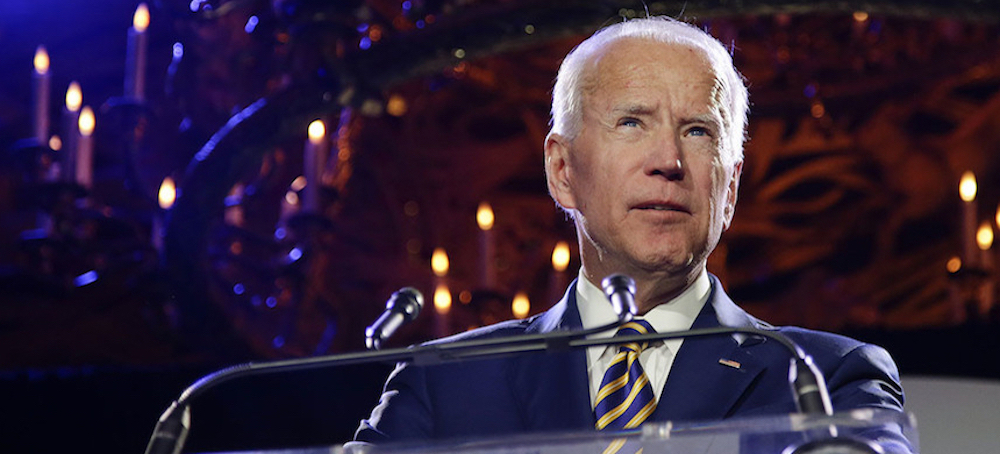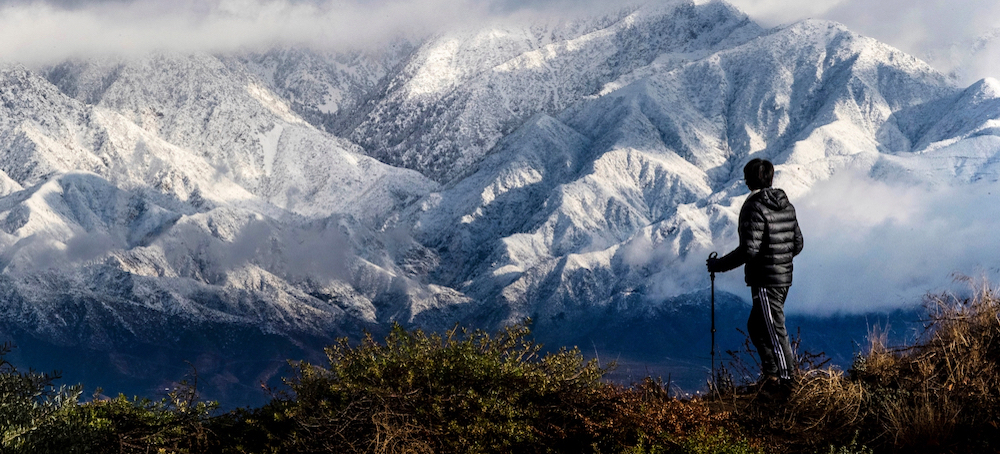Live on the homepage now!
Reader Supported News
It’s late on a weeknight at The Anthem, a 3,000-seat concert hall on the trendy, upscale D.C. waterfront that recently hosted Bush and the Disco Biscuits. The bar is open, but the venue’s floor is full of orderly rows of chairs, the air is uncharacteristically free of pot smoke, and the merch tables feature no T-shirts or posters, only stacks of the 81-year-old left-wing senator’s latest book, It’s OK to Be Angry About Capitalism. Still, to the overwhelmingly young crowd that has paid $55 to $95 per ticket, they might as well be seeing a rock star—the Mick Jagger of Medicare-for-All.
Callie Whicker, an 18-year-old student at American University, arrived an hour early and settled into her front-row seat, wearing a BERNIE sweatshirt and clutching a knit Bernie doll she got on Etsy. He’s her only source of hope in a coming-of-age that has otherwise been unrelentingly dark: “For Gen Z, coming up through Covid and Trump, we’ve given up,” she says. “Everything’s really bad. But knowing that there are people like him, people with decent hearts fighting for everybody, it’s so inspiring.”
Whicker has pink-dyed hair and wears a mask. Her homemade earrings dangle the words GENDER IS A CONSTRUCT from each lobe. When I ask her if it’s okay to be angry about capitalism, she looks at me like I might have the wrong number of heads. Isn’t it obvious? “Oh yes,” she says with conviction. “Of course, always.”
Sanders’s previous books were titled Our Revolution and Where We Go From Here—hopeful titles that looked to the future. The current one, with its combination of radicalism and neurosis, seems to signal a shift, not just in Sanders but in the ardent following he’s built over the last eight years and two near-miss presidential primary campaigns. His young followers are angry, yes, but they need to be reassured that it’s okay; they want to be comforted, to be affirmed in their feelings.
“We are very, very screwed,” says Farah T., a 30-year-old economist at the World Bank who declines to give her last name. “Angry is a nice word. It’s outrageous. It’s fucked up.” She paid $95 for her primo seat, which, yes, is capitalism—but why are people attacking Sanders for selling tickets when capitalism is responsible for so much worse? Sanders has been her lodestar for as long as she’s been politically conscious. Yet things have only seemed to get worse and worse. “He represents an America I would like to see, but probably never will, unfortunately,” she says.
Sanders’ fans have long admired his consistency, the way he’s been fighting for the same principles since he marched with Martin Luther King Jr. in the 1960s. But it has perhaps started to dawn on them that that’s another way of saying he hasn’t made much headway in all that time.
“I first got involved in climate activism in eighth grade,” says 19-year-old sociology student Jackie Wells. “Nothing significant has happened since then, and I’m going to another climate rally on Friday. Radical change is absolutely necessary, but I don’t know if our generation is up to it.” She worries that her peers are too complacent, too willing to mistake social-media posturing for activism. But Wells, who considers herself an anarcho-socialist, views the whole political system as a distracting spectacle. “I haven’t posted, like, ‘I’m at the Bernie thing,’ because it’s kind of embarrassing to like a politician,” she says.
“It’s not okay to not be angry about capitalism,” says Nicole Wilder, a 26-year-old editorial assistant. “If you’re not angry, I think you’re just not paying attention, or you’re a selfish person.” Older people, she says, shouldn’t disdain young people’s idealism and fervor for change: “Maybe that’s because a lot of young people actually give a s–t about things other than themselves.”
Chelsea Ihnacik, a 38-year-old stay-at-home mom, has been organizing a new Democratic Socialists of America chapter in her rural southern Maryland town. She worries that a Democratic Party that snubs Sanders in favor of milquetoast centrists like Joe Biden is destined to continue losing white working-class voters to Trumpism. “As much as Bernie woke us up to political engagement, the larger system is a monolith that’s not moving,” she says. “Biden betrayed the rail workers and undermined the solidarity of the working class. We’re going to lose those voters to fascism as a result.”
When Sanders comes on, the lights go all the way down, and he stands at the front of the stage in his usual hunched posture, gesturing with his right hand as he holds the microphone with his left. His rap has many of the same themes I remember from his 2016 campaign—the evils of oligarchy and super PACs, the billionaires robbing us blind and never paying a price. But there’s a new emphasis on capitalism’s emotionally taxing nature. “The bottom line, and we don’t talk about this at all, is that the working class of this country is under enormous emotional stress,” he says. “And stress kills.”
Gone, too, is Sanders’ onetime call for “political revolution,” perhaps because he’s become more enmeshed in the system he once sought to overthrow. After 16 years in the Senate, Sanders’ status as the pied piper of the resurgent young left has earned him real credibility—and power—in Washington. This year, he became the chairman of the Health, Education, Labor and Pensions committee, a position he intends to make the most of, hauling in pharmaceutical CEOs to testify about high drug prices, holding hearings on the plight of the working class. Next Tuesday, he tells the crowd, he plans to have the committee vote to subpoena Starbucks CEO Howard Schultz for his efforts to suppress unionization—a move that, if successful, would be the committee’s first-ever subpoena of a witness, according to Punchbowl News.
“The American people are standing up, and if I have anything to say about it—and as chairman of the relevant committee, I do have something to say about it—this is just going to be the start,” Sanders says to cheers. Audience members hold up their phones and record snippets of him speaking, like they would at a concert.
At the end, Sanders takes questions. The first one comes from a high schooler named Max who volunteered for his 2020 campaign. “What is your advice to the young people in this progressive movement on how we can keep the momentum of the movement you helped start alive?” Max wants to know.
Sanders looks out at the sea of eager faces, and I wonder if he’s thinking of his legacy—the ideals he’s seeded that will surely outlive him, the fresh-faced students who will keep fighting these fights long after he’s gone. “People often ask the question, what keeps me going?” he says, turning uncharacteristically sentimental. He recalls the millions of people he’s met, the places he’s been, the massive crowd of young people who turned out to see him as the sun set over a small town in rural California, hungry for a message of change.
“So I want to say that, as somebody who gets around the country and has the opportunity to meet with so many people, I don’t want you to become depressed about this country,” Sanders says. “There are millions of wonderful people who are trying to do the right thing. And our job is to educate and organize and create the kind of movement that will breed the kind of transformational change this country desperately needs.”
The lights come back on and Sanders departs, trailed by a lengthy standing ovation. And then the next generation trickles out of the theater, out into the night, out into the despair of the broken world they can’t escape.
READ MORE  Joe Biden. (photo: Frank Franklin II/AP)
Joe Biden. (photo: Frank Franklin II/AP)
The Biden administration has approved ConocoPhillips massive Willow oil drilling project, a reversal of his 2020 promise to eliminate new drilling permits
In a joint statement released through the House Natural Resources Committee, several Democratic lawmakers — including Sen. Ed Markey (D-Mass.), committee ranking member Raúl M. Grijalva (D-Ariz.), Alexandria Ocasio-Cortez (D-N.Y.), and Jared Huffman (D-Calif.) said the decision “ignores the voices of the people of Nuiqsut, our frontline communities, and the irrefutable science that says we must stop building projects like this to slow the ever more devastating impacts of climate change.”
Alongside its approval of the Willow project, the Biden administration announced that it will be placing more than 16 million acres of Alaskan Arctic land and water under federal protection from future drilling projects. Lawmakers expressed their disappointment with the Willow project’s exemption from these new protections. “Split decisions in the face of the climate crisis are not good enough,” read the statement from the Natural Resources Committee. “The only acceptable Willow project is no Willow project.”
The “split decision” wasn’t received well by Democrats on social media, either. Sen. Jeff Merkley (D-Ore.) called the approval a “complete betrayal of Biden’s promise not to allow more drilling and a complete catastrophe to rein in climate chaos.” The senator pointed to the hypocrisy in the decision, writing that the United States “can’t ask other countries to forego their fossil fuels if we keep greenlighting projects here in America.”
Rep. Rashida Tlaib wrote on Twitter that the project would have “devastating consequences on our planet, frontline communities, and wildlife.” Tlaib’s claim is bolstered by the Department of the Interior’s own analysis of the $8 billion project, which found “substantial concerns” regarding the project’s impact on wildlife in the region, and potential risk to freshwater sources.
Sen. Maria Cantwell (D-Wash.) expressed concerns regarding the continued delay of large scale investments in renewable energy sources. “We should be doubling down on energy solutions that can rapidly provide Americans with cleaner and more affordable alternatives,” Cantwell wrote.
Others argued that the promise to freeze new drilling permits in other federal lands would not offset the environmental impact of approving one of the largest fossil fuel projects in modern history, and that the carve-out for ConocoPhillips was a win for the oil industry. “Trading the huge Willow carbon bomb for conservation in other parts of the Arctic is a bad deal. I am not appeased by this split decision, and more importantly, neither is the climate crisis,” wrote Rep. Huffman.
Sen. Markey called for the administration to put “people and our planet ahead of Big Oil profits.”
“This decision not only leaves an oil stain on the administration’s climate accomplishments and the President’s commitment not to permit new oil and gas drilling on federal land, but slows our progress in the fight for a more livable future,” Markey wrote in a statement released on Twitter.
Days earlier, as rumors of the project’s approval leaked from the White House, Markey wrote that the decision was “a complete betrayal of Biden’s promise not to allow more drilling and a complete catastrophe to rein in climate chaos. You can’t ask other countries to forego their fossil fuels if we keep green lighting projects here in America.”
The Department of the Interior indicated on Monday that two of the five drilling sites proposed by ConocoPhillips had been rejected, thus reducing the scale of the project. “The actions will create an additional buffer from exploration and development activities near the calving grounds and migratory routes for the Teshekpuk Lake caribou herd, an important subsistence resource for nearby Alaska Native communities,” the department wrote in a statement. “They significantly scale-back the Willow Project within the constraints of valid existing rights under decades-old leases issued by prior Administrations.”
Those constraints are the fact that ConocoPhillips has owned the drilling rights of the land for decades, a position legal experts say makes it difficult for the president to outright block the project from moving forward.
But as Jamal Raad, co-founder of the climate group Evergreen Action told The Washington Post, “this does not negate or discount the climate impacts of the Willow project in any way, shape or form.”
“It’s lipstick on a pig,” he added.
READ MORE  Silicon Valley Bank (SVB), over decades, became the go-to bank for startups. (photo: Bloomberg)
Silicon Valley Bank (SVB), over decades, became the go-to bank for startups. (photo: Bloomberg)
Analysts say US Federal Reserve will probably reject further increase in borrowing costs next week
Analysts said the US Federal Reserve would probably leave interest rates on hold at its decision next week, as the meltdown at the California-based technology lender rippled through global financial markets.
Against a backdrop of concern over contagion spreading through the wider global banking industry, financial market expectations for significant further rate increases from the Bank of England and the European Central Bank also eased on Monday.
Goldman Sachs said the Fed would probably keep rates on hold at the current level of 4.5% to 4.75%, after previously expecting another rise.
“In light of the stress in the banking system, we no longer expect the FOMC [federal open markets committee] to deliver a rate hike at its next meeting on 22 March (v our previous expectation of a 25 basis point hike),” analysts at the bank wrote in a note to clients.
It said the US central bank would probably raise rates by 0.25 percentage points in May, June and July as it sought to counter high levels of inflation, before a peak in rates of 5.25% to 5.5%. “Though we see considerable uncertainty about the path,” they added.
Analysts at financial services group Nomura went as far as to predict that the Fed would cut rates at its meeting next week.
“We expect a 25 basis point rate cut and a halt of balance sheet reduction in March, while a new lending facility is possible,” they wrote in a newsletter.
As recently as last week, before the failure of SVB, a rate increase of 0.5 percentage points had been expected in financial markets, after the Fed chair, Jerome Powell, warned that more increases would be required to cool inflation.
The Bank of England had been given an almost 100% probability by traders in financial markets of raising rates by 0.25 percentage points at its next meeting on 23 March. However, that has since fallen to a 71% chance as City traders assess the consequences of SVB’s failure.
Economists said financial stability concerns after SVB’s collapse would probably force banks to act more cautiously when issuing loans – in effect doing some of the same job as higher borrowing costs. However, they also said SVB’s failure showed delayed impacts from the most aggressive rate-rising cycle in decades were feeding through.
“The Fed is starting to break things,” said John Briggs, the global head of economics and markets strategy at NatWest. He said he expected the Fed to lean towards a 25 basis point rise rather than 50 basis points that was previously expected.
“If tightening to date is starting to break things, then the Fed may not want to pile on more,” Briggs said.
SVB’s collapse came after the bank invested heavily in US government bonds two years ago, at a time when it had healthy deposit levels concentrated in the tech sector and among venture capital investors. With a fall in US government bond prices as the Fed raised interest rates, the value of its investments dropped. It also faced rising demands to return cash to depositors as the tech sector came under pressure.
On Monday morning it was announced that HSBC would buy SVB’s UK operations for £1, after a weekend of emergency talks between the UK government, the Bank of England and potential suitors.
“They were super exposed to tech venture capital depositors who had been seeing cash burn as the tech bubble burst, while previously having loaded up their balance sheet with positive carry trades into bonds when deposits soared during the tech boom and ultra low rate environment circa 2021,” analysts at Deutsche Bank wrote in a note to clients.
Suggesting that “something always, always breaks when the Fed hikes”, they said three factors had hit the bank: tech companies requirements for cash, higher deposit rates on offer than SVB could provide elsewhere as interest rates rose, and finally “fear” over the stability of SVB after it sold about $21bn (£17bn) of its bond portfolio for a steep loss last week. “Ultimately we saw an irreversible bank run.”
READ MORE  Women watch and embrace each other as bodies are exhumed from a mass grave and inspected by the authorities for possible war crimes in Bucha. (photo: Laurel Chor/SOPA Images/Sipa USA)
Women watch and embrace each other as bodies are exhumed from a mass grave and inspected by the authorities for possible war crimes in Bucha. (photo: Laurel Chor/SOPA Images/Sipa USA)
The source said the arrest warrants could include the crime of genocide, and were expected to arrive in the "short term" if the court prosecutor's request was approved by a pre-trial judge at the Hague-based court. It was unclear which Russian officials the prosecutor might seek warrants against.
The office of the prosecutor at the ICC declined to comment.
Russia's defence ministry did not immediately respond to a request for comment.
Moscow would be certain to reject any arrest warrants against any of its officials. But an international war crimes prosecution could deepen Moscow's diplomatic isolation and make it difficult for those accused to travel abroad.
Konstantin Kosachyov, deputy speaker of Russia's upper house of parliament, said the ICC had no jurisdiction over the country since Moscow withdrew its backing in 2016. "The ICC is an instrument of neo-colonialism in the hands of the West," he said.
Russia denies deliberately targeting civilian infrastructure in Ukraine, saying its attacks are all intended to reduce Kyiv's ability to fight. It has not concealed a programme under which it has brought thousands of Ukrainian children to Russia, but presents it as a humanitarian campaign to protect orphans and children abandoned in the conflict zone.
Kyiv says thousands of deported Ukrainian children are being adopted into Russian families, housed in Russian camps and orphanages, given Russian passports and brought up to reject Ukrainian nationality.
The U.N. genocide convention defines "forcibly transferring children of the group to another group" as one of five acts that can be prosecuted as genocide. Asked if the ICC charges against the Russian officials could include genocide, the source said: "It looks that way."
'THERE IS A LOT OF ARTILLERY'
On the ground, both sides described relentless fighting in and around Bakhmut, a small ruined city in eastern Ukraine that has become the main focus of a Russian winter campaign.
Near Kreminna, north of Bakhmut, Ukrainian soldiers said they were repelling intensified attacks by increasingly professional soldiers, while heavy equipment was being brought closer to the frontline by the Russians.
In a forest some 8 km (5 miles) from the front, cannons boomed, targeting enemy positions to the northeast. Explosions rumbled constantly in the distance, a sign of heavy fighting.
Reuters reporters saw a soldier being brought from the front with a badly wounded leg. He was stabilised in a van with a splint and painkillers before being taken to a medical centre further from the front.
"Two or three weeks ago the fighting was at its peak but it has calmed down a bit," said Mykhailo Anest, a 35-year-old medic. "There is a lot of artillery and mortar fire."
On a bad day he would see 20 wounded troops in a single day from his battalion, he told Reuters.
The months-long fight for Bakhmut has become Europe's bloodiest infantry battle since World War Two.
Russian forces led by the Wagner private army have captured the city's eastern part but so far failed to encircle it.
"All enemy attempts to capture the town are repelled by artillery, tanks, and other firepower," Ukraine's Colonel general Oleksandr Syrskyi, the commander of ground forces who has vowed not to withdraw, was quoted as saying by Ukraine's Media Military Centre.
Wagner founder Yevgeny Prigozhin said on Sunday the situation was "tough, very tough".
Moscow says taking it would be a major success, opening a path to capture the rest of the surrounding Donetsk region, a central war aim.
Kyiv says it has decided not to pull out because it is inflicting huge losses on the Russian assault force which will make it easier to stage a counterattack later this year.
CHINA DIPLOMACY
As the fighting ground on in eastern Ukraine, Moscow appeared on the cusp of one long-sought diplomatic breakthrough: several sources told Reuters that China's President Xi Jinping could visit Russia as soon as next week, an earlier-than-expected response to a long-standing invitation.
The Chinese foreign ministry did not immediately respond to requests for comment. The Kremlin said it had nothing to announce yet.
President Vladimir Putin has touted such a visit as a show of support, but it could be overshadowed by plans for Xi to speak by video link to Ukraine's President Volodymyr Zelenskiy for the first time since the invasion.
The plans for talks between Zelenskiy and Xi were reported by the Wall Street Journal. Reuters could not immediately confirm them and Ukraine's president's office did not immediately respond.
A visit by Xi to Russia would be a major event for Putin, who portrays the war in Ukraine as a conflict with the combined might of the West. Russia relies on China to buy oil and gas it can no longer sell in Europe.
But a video meeting with Zelenskiy could be an even bigger coup for the Ukrainians, who want Beijing to remain neutral rather than firm up support for Moscow.
U.S. national security adviser Jake Sullivan told reporters aboard Air Force One that Ukraine had not confirmed a call between Xi and Zelenskiy.
Sullivan said Washington has been publicly and privately encouraging Xi to talk to Zelenskiy so that they hear "not just the Russian perspective" on the war.
China has declined to ascribe blame for the war while opposing Western sanctions against Russia. It unveiled a proposal in February for a peace plan, met with scepticism in the West but praised in Moscow and cautiously welcomed by Zelenskiy.
China and Russia struck a "no limits" partnership in February of 2022, weeks before Russia invaded Ukraine, and the two sides have reaffirmed the strength of their ties in public.
READ MORE  Pro-choice protesters march outside the Texas State Capitol in Austin. (photo: Sergio Flores/WP)
Pro-choice protesters march outside the Texas State Capitol in Austin. (photo: Sergio Flores/WP)
Transparency is among the most important features of our judiciary. “Sunlight,” Supreme Court Justice Louis D. Brandeis wrote before joining the court, “is said to be the best disinfectant.” Decades later, Chief Justice Warren Burger applied that principle to the courts: “The crucial prophylactic aspects of the administration of justice cannot function in the dark.”
Dimmed light may be what Kacsmaryk prefers as he conducts his judicial process, but the outcome in this fraught action—which anti-abortion groups maneuvered into his courtroom—will not escape the people’s attention. The hyper-right Texas judge is expected to rule that the U.S. Food and Drug Administration improperly approved mifepristone, one of the pills in two-part medication abortions, a full 22 years ago. It has been safely used ever since.
What’s worse is that most observers think Kacsmaryk will issue an injunction halting the distribution of the drug, including in states where abortion is legal. That would exceed what the Supreme Court did in last June’s Dobbs decision, overturning Roe v. Wade but at least leaving women’s reproductive rights intact in states that opt to respect them.
The problem here goes beyond a single hearing, or even this single case. The real issue is systemic. Far-right groups have created a judicial pipeline to predictable triumph in one culture war battle after another: from Kacsmaryk in the plains of the Texas panhandle, to the hyperconservative U.S. Court of Appeals for the 5th Circuit, to the radically stacked majority on the Trump-packed U.S. Supreme Court. One Amarillo-based judge with carte blanche, virtually certain his extreme views will prevail on appeal, is apparently planning to curtail abortion access across the country.
What’s happening is not mere “judge-shopping,” as many have called it. That term is traditionally used to describe an individual’s search for a nearby court inclined to rule favorably.
By contrast, here there’s a coordinated national strategy, enabled by a district court federal bench, to bring right-wing legal causes into a single courtroom where a favorable result is a sure thing and where fair-minded appellate review has also been hijacked.
Let’s start with the local bench. In 1988, Congress left an easily closed loophole in the procedure for assigning cases to federal judges that made such gaming of the system possible. In July 2019, the judges of the Northern District of Texas took advantage of that loophole. They issued a special order funneling to Judge Kacsmaryk every case filed anywhere in the 25,914-square-mile area of the Amarillo Division in which he sits.
Groups throughout the country sharing his religious-political ideology have found it easy to establish a plaintiff’s residence within that sprawling 26-county region. Their goal is to ensure that test cases they design will land on his desk, even though the real forces behind the suit are national or global in reach.
Consider the anti-abortion groups that brought this case to Kacsmaryk. They know he previously worked at the First Liberty Institute, a Christian conservative litigation operation that opposes women’s reproductive freedom. Before Kacsmaryk’s appointment to the bench, he wrote that the “erotic desires of liberated adults” had taken priority over marriage and the unborn child.
And so national anti–reproductive rights organizations homed in on his judicial fiefdom. The complaint in the abortion pill case says that the named plaintiff, the Alliance of Hippocratic Medicine—incorporated just months before filing suit—is based near Amarillo. Rolling Stone reports that its mailing address is actually in Tennessee, but that is no impediment to gaining access to Kacsmaryk’s Texas courtroom due to the loophole that Congress left open and that conservatives are driving their truck through.
Kacsmaryk’s views on abortion fit neatly into his right-wing political cosmology. Before this suit was filed, he held that the Affordable Care Act’s prohibition of discrimination “on the basis of sex” does not cover sexual orientation. That case was brought by lawyers for former Trump aide Stephen Miller’s America First Legal Foundation, a group based in Washington, D.C., that also found easy access to Kacsmaryk.
He also vacated the Biden administration’s protections for transgendered persons under Title VII. Texas Republican Attorney General Ken Paxton brought that case in Amarillo, even though it’s 496 miles—a seven-hour drive—from Austin, where Paxton’s main office is located. Never mind that there’s a federal district court for the Western District of Texas in Austin.
That so transparently unprincipled a course is being charted by the newly emboldened ideological juristocrats is a tragedy for human rights—as well as for the broad public respect essential to an independent judiciary and therefore to the rule of law. The nation could easily get stuck in the judicial trench the right wing is digging by way of a single courtroom.
Getting out will take persistent organizing effort within our political system. We need to elect a Congress that will exercise its authority to modify federal court jurisdiction. We need a Congress willing to pass a bill that says, “No more single-judge district courts where parties on either side of the aisle can handpick extremist judges to manipulate national policy.”
Given the extent to which its conservative forces are taking advantage of the loophole, any reform will require that Democrats win a trifecta in 2024—election of a majority in both houses of Congress, including a Senate that is willing to reform the filibuster, and a president committed to the vision of a more perfect union of individual rights.
To be sure, pulling it off is a long shot. But it’s an imperative if we are to keep an ideological juristocracy from destroying our freedom.
READ MORE An Uber vehicle in Los Angeles. (photo: LA Times)
An Uber vehicle in Los Angeles. (photo: LA Times)
The ruling preserves most of Prop 22, a ballot initiative that Uber, Lyft, and others passed in 2020 to preserve their business models.
The Monday decision from California’s First District Court of Appeals vindicates tech companies and undercuts organized labor foes who challenged an industry ballot initiative exempting the firms from a sweeping new labor law. Judges reversed most of a lower court decision that had invalidated Proposition 22 in its entirety.
“Today’s ruling is a historic victory for the nearly 1.4 million drivers who rely on the independence and flexibility of app-based work to earn income, and for the integrity of California’s initiative system,” the Protect App-Based Drivers + Services coalition said in a statement.
But the ruling could still hand a significant victory to unions and worker advocates. It invalidated a provision of Prop 22 that sets a high bar for the Legislature to pass laws allowing workers to organize.
“We are grateful that the California Court of Appeal has affirmed that companies like Uber, Lyft, Doordash and Instacart can’t keep drivers from joining together in a union through their deceptive ballot measure,” plaintiff and driver Mike Robinson said in a statement.
The legal battle has extended a long-running fight over the status of gig workers in California. In 2019, the state passed a law that made effectively compelled companies to classify their workers as employees, not contractors, by enshrining a California Supreme Court Decision.
After failing to block the law in Sacramento, tech companies fought back at the ballot box by pouring hundreds of millions of dollars into passing Prop 22. A labor-backed coalition then challenged the law as unconstitutional.
READ MORE  Hotter, drier conditions driven by climate change in the mountain range have made certain regions once hospitable to conifers - such as sequoia, ponderosa pine and Douglas fir - an environmental mismatch for the cone-bearing trees. (photo: Watchara Phomicinda/AP)
Hotter, drier conditions driven by climate change in the mountain range have made certain regions once hospitable to conifers - such as sequoia, ponderosa pine and Douglas fir - an environmental mismatch for the cone-bearing trees. (photo: Watchara Phomicinda/AP)
Hotter, drier conditions driven by climate change in the mountain range have made certain regions once hospitable to conifers — such as sequoia, ponderosa pine and Douglas fir — an environmental mismatch for the cone-bearing trees.
"They were exactly where we expected them to be, kind of along the lower-elevation, warmer and drier edges of the conifer forests in the Sierras," Avery Hill, who worked on the study as a graduate student at Stanford University, told NPR.
Although there are conifers in those areas now, Hill and other researchers suggested that as the trees die out, they'll be replaced with other types of vegetation better suited to the environmental conditions.
The team estimated that about 20% of all Sierra Nevada conifer trees in California are no longer compatible with the climate around them and are in danger of disappearing. They dubbed these trees "zombie forests."
The environment is changing faster than the trees can adapt
The team scrutinized vegetation data dating back to the 1930s, when all Sierra Nevada conifers were growing in appropriate climate conditions. Now, four out of five do.
That change is largely due to higher temperatures and less rainfall in these lower-elevation areas, as well as human activities, such as logging, and an uptick in wildfires.
The Sierra Nevada conifers aren't standing still. The average elevation of the trees has increased over the past 90 years, moving 112 feet upslope. According to Hill, that's because lower-elevation conifers have died while conifers at higher elevations where the air is cooler have been able to grow.
But the conifers' uphill trek hasn't been able to keep pace with the dramatic increase in temperatures.
The researchers said the number of Sierra Nevada conifers incompatible with their environments could double in the next 77 years.
The new maps can inform forest conservation and management plans
But Hill, who is now a postdoctoral researcher at the California Academy of Sciences, hopes that the maps he and his colleagues developed showing the state's "zombie forests" will help shape people's understanding of the effects of climate change.
"Conservationists know, scientists know, so many people know that ecosystems are changing and expect them to change more, and people are grappling with this," he said.
"These maps are unique, in that you can put your finger on a point and say, 'This area right here is expected to transition due to climate change in the near future,' and this forces some really difficult questions about what we want this land managed for and do we try to resist these impending changes," Hill added.
Follow us on facebook and twitter!
PO Box 2043 / Citrus Heights, CA 95611



No comments:
Post a Comment
Note: Only a member of this blog may post a comment.